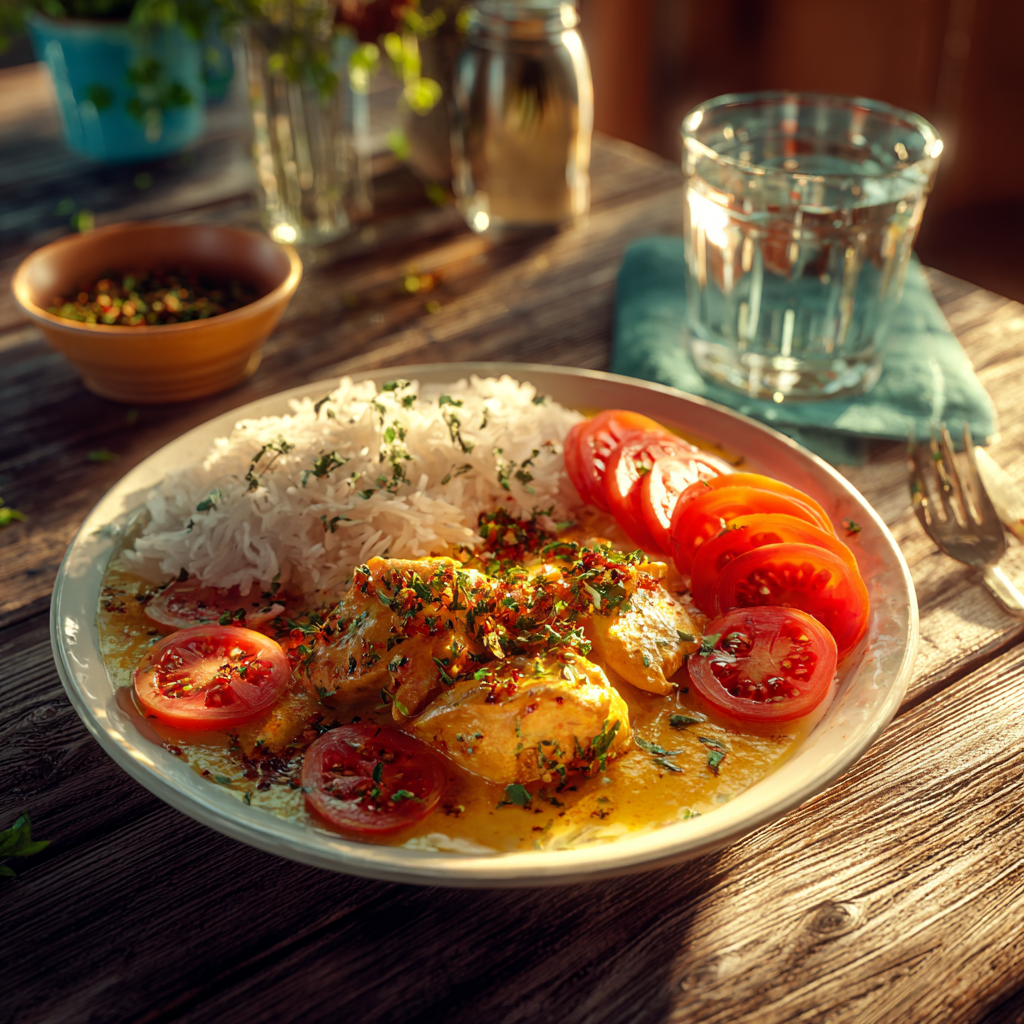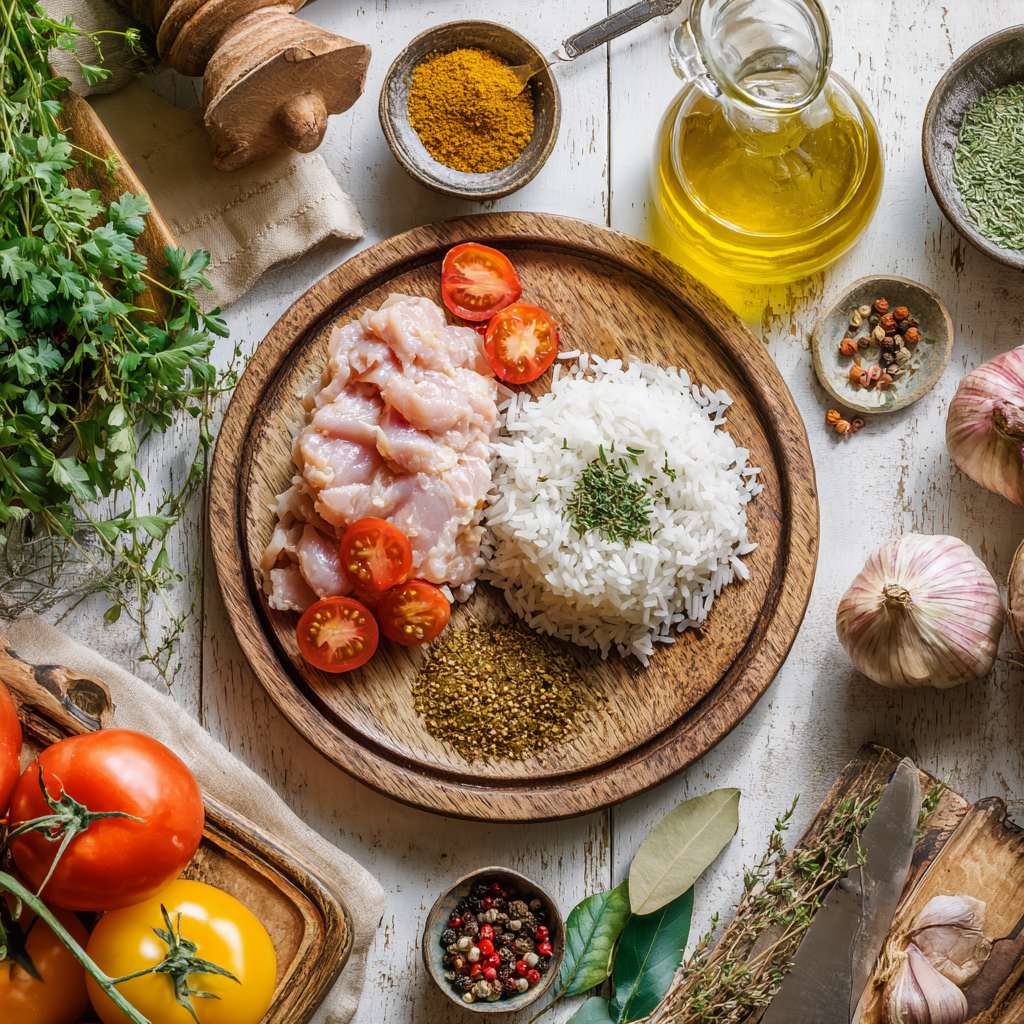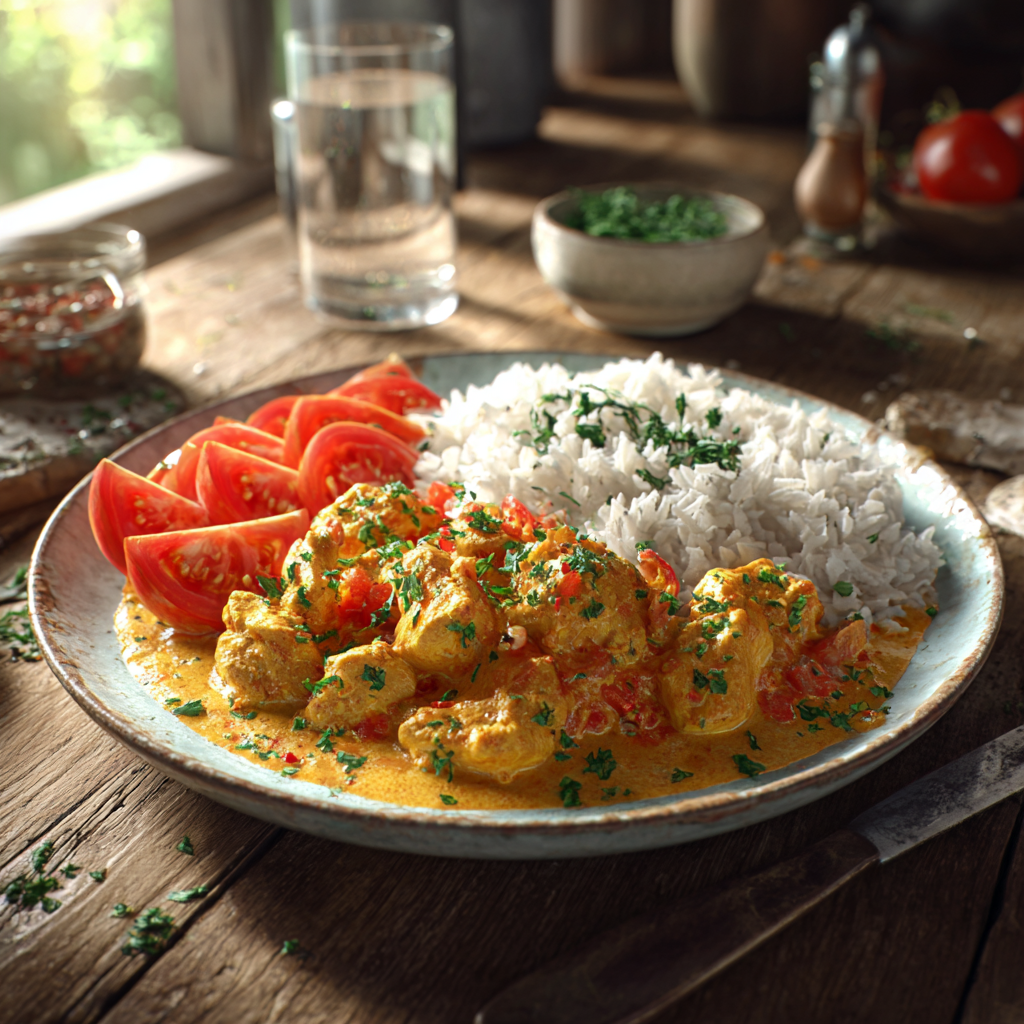Introduction
Growing up in a Filipino household, I learned early on that food is more than just sustenance. It’s love served on a plate. Among the many dishes my lola (grandmother) used to cook, her chicken curry recipe Tagalog-style stood out. The aroma of turmeric and coconut milk simmering together is forever etched in my memory. It’s no wonder this dish holds a special place in Filipino kitchens. Today, I’ll share why you should give it a try—and how you can make it shine at home.
In this article, you’ll discover the key ingredients that define Filipino chicken curry, what sets it apart from other curries, and simple steps to recreate it. Plus, I’ll share tips for making your curry unforgettable. Whether you’re new to cooking or a seasoned home chef, this dish is worth adding to your repertoire.
What is Chicken Curry and Why Should You Try It?
Let me tell you something: there’s nothing quite like the comforting warmth of a bowl of Filipino chicken curry. It’s rich, flavorful, and perfect for any occasion. Whether it’s a family dinner or a solo meal, this dish has a way of bringing people together. I still remember the first time I made it myself. I was nervous, but once I tasted that creamy, spiced goodness, I knew I had nailed it.
So, what makes Filipino chicken curry different? Unlike Indian or Thai curries, which often rely on complex spice blends or heat levels, Filipino curry strikes a balance. It’s mild yet packed with flavor, thanks to its signature ingredients: turmeric, coconut milk, and local spices. These elements create a dish that’s uniquely ours—familiar yet distinct.
Here’s a quick look at the core ingredients:
- Turmeric: Adds vibrant color and earthy flavor.
- Coconut milk: Makes the sauce creamy and rich.
- Ginger and garlic: Infuse warmth and depth.
- Potatoes and carrots: Add texture and sweetness.
- Curry powder: The base spice blend ties everything together.
These ingredients work harmoniously to create a curry that’s both comforting and exciting. While some versions might include bell peppers or raisins for extra flair, the basics remain the same. And don’t worry—you don’t need fancy equipment or hours of prep time to pull it off.
One thing I love about Filipino curry is its adaptability. If you prefer a thicker sauce, simmer it longer. Want it spicier? Add chili flakes or fresh chilies. It’s all about making it your own while respecting the dish’s roots.
Now, let’s talk about what truly sets this curry apart. Many people ask, “What makes Filipino curry different?” Well, unlike Indian curries, which often feature garam masala or fenugreek, Filipino curry keeps things simpler. The focus is on turmeric and curry powder, creating a milder taste profile. Compared to Thai curries, which use lemongrass and kaffir lime leaves, Filipino curry leans more toward creaminess from coconut milk rather than citrusy notes.
Another secret lies in the cooking process. Sautéing onions, ginger, and garlic forms the flavor base, much like in other Filipino dishes. This technique ensures every bite bursts with savory goodness. Then, when the chicken simmers in the spiced coconut milk, magic happens. The flavors meld beautifully, resulting in a dish that’s greater than the sum of its parts.
If you’ve ever wondered, “What is the secret to a good curry?”, here’s my take: patience and quality ingredients. Let the flavors develop slowly over low heat. Use fresh ginger and garlic instead of powdered versions. And don’t skimp on the coconut milk—choose full-fat for maximum creaminess.
To wrap up this section, let me reassure you. Making Filipino chicken curry isn’t as intimidating as it might seem. With the right guidance, you’ll have a delicious meal ready in no time. In the next part, we’ll dive deeper into the step-by-step process so you can confidently cook this dish yourself. Stay tuned!
Essential Ingredients for Chicken Curry Recipe Tagalog
Alright, let’s get into the nitty-gritty of what makes a chicken curry recipe Tagalog-style stand out. If you’ve ever wondered, “What are the ingredients of Filipino chicken curry?”—you’re in the right place. Trust me, it’s not rocket science. The beauty of this dish lies in its simplicity and accessibility. Most of these ingredients are probably already sitting in your pantry or fridge.
Here’s the thing: while some curries from other cuisines can feel overwhelming with their long lists of spices, Filipino chicken curry keeps it straightforward. You’ll need just a handful of key players to whip up something truly delicious. Let’s break it down.
The Star Players: What You Need
First up is the chicken. I usually go for bone-in, skin-on pieces because they add more flavor as they simmer. Plus, who doesn’t love that tender, fall-off-the-bone texture? If you’re watching your fat intake, though, boneless works too. No judgment here!
Next, we’ve got potatoes. They’re not just filler—they soak up all those amazing flavors from the sauce. Yukon Golds are my go-to since they hold their shape well and have a buttery taste. But honestly, any kind will do.
Now, onto the liquid gold: coconut milk. This is where the magic happens. It gives the curry its signature creaminess and balances out the spices. Full-fat coconut milk is non-negotiable if you want that rich mouthfeel. Don’t skimp on this one; trust me, it makes all the difference.
Curry powder is another must-have. Unlike Indian curries, which often use freshly ground spices, Filipino versions rely on good ol’ curry powder for convenience. Look for one with turmeric as a main ingredient—it adds that vibrant yellow hue and earthy undertones.
And how could I forget the aromatics? Garlic, onions, and ginger form the trifecta that builds the flavor base. Fresh is always best here. Sure, you could use pre-minced garlic or powdered ginger, but why would you when fresh tastes so much better?
Lastly, don’t skip the fish sauce. A splash at the end ties everything together with a salty umami kick. Funny enough, it’s one of those things you might not notice outright, but without it, the dish feels incomplete.
Substitutions and Swaps
By the way, life happens, and sometimes you won’t have every single item on hand. That’s okay! For example, if you can’t find curry powder, try mixing ground turmeric, cumin, and coriander. It won’t be exactly the same, but it’ll still taste great.
If fish sauce isn’t your jam—or if you’re vegan—you can swap it out for soy sauce or even a pinch of salt. Just keep in mind that fish sauce has a unique funkiness that really elevates the dish. Speaking of vegan options, tofu or chickpeas can stand in for chicken if you’re going meat-free.
Oh, and carrots? Totally optional, but they add a touch of sweetness and color. If you’re feeling adventurous, throw in some bell peppers or even raisins for extra flair. Some folks swear by adding a bit of Cracker Barrel Chicken and Rice Recipe to give it an interesting twist, though I haven’t tried that myself yet.
How to Make Chicken Curry Simple Recipe
Okay, now that we’ve covered the essentials, let’s dive into the fun part: actually making the dish. Don’t worry—it’s easier than you think. In fact, once you’ve got the hang of it, you’ll wonder why you didn’t start sooner. Ready? Let’s roll.
Prepping Your Ingredients
Before you even turn on the stove, take a few minutes to prep everything. Cooking moves fast, and you don’t want to be chopping onions while your garlic burns (trust me, I’ve been there). Cube your potatoes, slice your onions, mince your garlic, and grate your ginger. Keep them handy.
Pro tip: pat your chicken dry with paper towels before seasoning. This helps it brown nicely instead of steaming in the pan. And hey, if you’re using boneless chicken, cut it into bite-sized chunks. Makes serving a breeze later.
Cooking the Chicken
Start by heating a bit of oil in a large pot over medium heat. Once it’s shimmering, toss in your chicken pieces. Let them sear for a few minutes on each side until golden brown. Don’t overcrowd the pot—work in batches if needed. Overcrowding leads to steaming, which means soggy skin. Nobody wants that.
Once the chicken is browned, remove it and set it aside. Now it’s time to sauté your aromatics. Throw in the onions first, letting them soften and turn translucent. Then add the garlic and ginger. Be careful not to burn them; they cook quickly. Stir constantly and breathe in that heavenly aroma. Isn’t it amazing?
Adding the Sauce
With your base ready, sprinkle in the curry powder. Toast it lightly for about 30 seconds to wake up the spices. Next, pour in the coconut milk, scraping up any brown bits stuck to the bottom of the pot. Those little bits? Pure flavor bombs.
Add your potatoes next, along with enough water or broth to cover everything halfway. I like using Chicken and Wild Rice Soup Publix Recipe stock for an added layer of depth, but plain water works fine too. Bring it to a boil, then reduce the heat and let it simmer gently.
After about 15 minutes, return the chicken to the pot. Cover and continue simmering until the chicken is cooked through and the potatoes are fork-tender. Depending on the size of your potato cubes, this should take around 20-25 minutes. Check occasionally and stir to prevent sticking.
Tips for Success
Here’s the deal: timing matters. If your potatoes aren’t done but your chicken is falling apart, you may have cut your spuds too big. On the flip side, tiny potatoes might disintegrate before the chicken finishes cooking. Aim for uniformity—it’s key.
Want to amp up the flavor? Add a splash of fish sauce towards the end. Seriously, it transforms the dish. And if you’re looking for inspiration, check out this Chicken Curry Recipe Pinoy guide for additional tips.
One last note: patience pays off. Letting the curry simmer slowly allows the flavors to meld beautifully. Rushing it won’t give you the same result. Think of it like slow dancing versus sprinting—the former always feels smoother.
For a final touch, garnish with fresh cilantro or green onions. Serve it alongside steamed rice, and voilà! You’ve just made a killer chicken curry recipe Tagalog-style. Honestly, it’s dishes like this that remind me why Filipino food is so special. Cozy, comforting, and full of heart.
If you’d like to explore similar recipes, this Recipe Filipino Chicken Curry article offers a slightly different take worth trying. Enjoy experimenting!
The Secret to a Great Chicken Curry
Let’s get real for a second. If you’ve ever wondered, “What is the secret to a good curry?”—and trust me, I’ve asked myself this countless times—it all boils down to three big things: balancing spices, mastering simmering techniques, and layering flavors. It’s not about having the fanciest ingredients or the most expensive pots. Nope. It’s about understanding how each step builds on the last. Let me break it down for you.
First off, spice balance is key. Too much turmeric? You’ll end up with something that tastes like a yellow brick. Not enough curry powder? The dish feels bland, like it’s missing its soul. Over the years, I’ve learned to start small. Add a teaspoon of curry powder at a time, tasting as I go. Funny enough, I once dumped an entire tablespoon in one shot, thinking more was better. Spoiler alert: it wasn’t. Lesson learned. Balance is everything, and patience while seasoning pays off.
Simmering technique is another game-changer. Here’s the thing: you can’t rush a good curry. I know life gets busy, but if you crank the heat too high, your sauce will separate, and your chicken might dry out. Low and slow is the mantra. I remember making curry for a family dinner once, and I got impatient. Instead of letting it simmer gently, I cranked the stove to medium-high. Big mistake. The coconut milk curdled, and the whole dish looked like a science experiment gone wrong. Ever since, I’ve stuck to a gentle simmer, stirring occasionally, and letting the magic happen naturally.
Now, layering flavors. This is where Filipino chicken curry truly shines. Start by sautéing your aromatics—onions, garlic, ginger—until they’re soft and fragrant. Then toast your spices lightly before adding liquids. This simple step wakes up the flavors and makes a world of difference. Think of it like building a house: the aromatics are your foundation, the spices are your walls, and the coconut milk is your roof. Skip any part, and the whole thing feels incomplete.
By the way, here’s a little trick I picked up from my lola. She always added a splash of calamansi juice at the very end. It’s subtle, but it brightens the dish just enough to make your taste buds sing. I didn’t believe her at first—I thought citrus would clash with the creaminess—but oh boy, was I wrong. Try it yourself. A squeeze of calamansi or even lemon works wonders.
Another pro tip? Don’t skip the resting time. Once your curry is done cooking, turn off the heat and let it sit for 10-15 minutes. This gives the flavors time to marry and deepen. It’s like letting wine breathe before serving. One time, I served my curry straight off the stove without resting it, and while it was still tasty, it lacked that extra oomph. Resting is non-negotiable now.
Oh, and here’s something random but important: use fresh ingredients whenever possible. Fresh ginger beats powdered every single time. Same goes for garlic. Sure, pre-minced stuff is convenient, but it doesn’t pack the same punch. Plus, chopping fresh aromatics fills your kitchen with the most incredible smell. Makes you feel like a culinary rockstar.
Speaking of convenience, though, don’t shy away from shortcuts when needed. Life happens, right? Some days, I don’t have time to chop veggies, so I grab a bag of frozen mixed vegetables. Does it taste exactly the same? Not quite, but it’s close enough—and way better than ordering takeout. Just promise me you won’t skimp on the coconut milk. That’s where the heart of the dish lies.
If you’re looking for inspiration beyond this chicken curry recipe Tagalog, check out the main category page. There are tons of other Filipino recipes waiting to be discovered. Seriously, exploring new dishes keeps cooking exciting and fun.
Frequently Asked Questions About Chicken Curry Recipe Tagalog
- What are the ingredients of Filipino chicken curry?
Traditional Filipino chicken curry includes chicken (bone-in preferred), coconut milk, potatoes, onions, garlic, ginger, curry powder, and fish sauce. Optional additions like carrots, bell peppers, or raisins can enhance flavor and texture. - What makes Filipino curry different?
Filipino curry stands out due to its mildness and simplicity compared to Indian or Thai versions. It relies heavily on turmeric, curry powder, and coconut milk for creaminess rather than complex spice blends or fiery heat. - How to make chicken curry simple recipe?
Sauté onions, garlic, and ginger, then brown the chicken. Add curry powder, coconut milk, and vegetables like potatoes. Simmer until tender, season with fish sauce, and serve over rice. Easy peasy! - What is the secret to a good curry?
The secret lies in balancing spices, simmering slowly, and layering flavors. Toasting spices and allowing the curry to rest after cooking also elevate the dish significantly. - Can I use water instead of broth in chicken curry?
Absolutely! While broth adds depth, water works perfectly fine. For extra flavor, consider adding a bouillon cube or a splash of soy sauce. - Is fish sauce necessary in Filipino curry?
Fish sauce isn’t strictly necessary, but it adds a salty umami kick that ties the dish together. Substitute with soy sauce or salt if needed. - Can I freeze leftover chicken curry?
Yes! Cool the curry completely before transferring it to an airtight container. Freeze for up to 3 months. Reheat gently on the stovetop or microwave. - How do I prevent coconut milk from curdling?
Avoid boiling coconut milk vigorously. Instead, simmer it gently and stir frequently. If separation occurs, whisk vigorously to recombine. - What can I substitute for curry powder?
Mix ground turmeric, cumin, coriander, and a pinch of cayenne for a DIY alternative. Adjust quantities based on your taste preferences. - Why does my curry taste bland?
Bland curry often results from under-seasoning or skipping key steps like toasting spices. Taste as you cook, adjust seasonings, and let the dish rest for deeper flavors.
Conclusion
Cooking a chicken curry recipe Tagalog at home isn’t just about feeding yourself—it’s about creating memories. Whether you’re sharing it with loved ones or savoring it solo, there’s something magical about transforming humble ingredients into a comforting meal. So roll up your sleeves, embrace the process, and trust your instincts. You’ve got this.
And hey, once you nail this recipe, why stop there? Filipino cuisine has so much more to offer. From adobo to sinigang, there’s always something new to try. Keep experimenting, keep sharing, and most importantly, keep enjoying the journey. Happy cooking!

Chicken Curry Recipe Tagalog
Ingredients
Equipment
Method
- Pat chicken dry with paper towels and season it.
- Heat oil in a large pot over medium heat and sear the chicken pieces until golden brown. Remove and set aside.
- Sauté onions until translucent, then add garlic and ginger, stirring until fragrant.
- Sprinkle in the curry powder and toast for about 30 seconds.
- Pour in coconut milk, scraping up any browned bits from the bottom of the pot.
- Add cubed potatoes and enough water to cover everything halfway; bring to a boil.
- Reduce heat and return chicken to the pot, simmering gently until the chicken is cooked through and potatoes are tender, about 20-25 minutes.
- Add fish sauce towards the end and stir to combine.
- Rest the curry for 10-15 minutes before serving.
- Garnish with fresh cilantro or green onions and serve with steamed rice.


